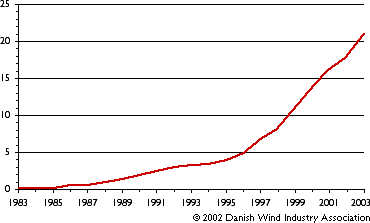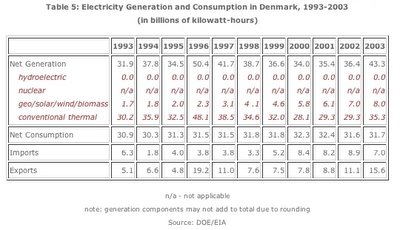213. SOMETHING FISHY IN DENMARK
Wind is booming in Denmark:

According to the Danish Wind Industry Association, 20% of power consumed in Denmark in 2004 came from wind.
So why has Danish conventional thermal generating capacity remained constant (click Table to enlarge)?

And why hasn't there been a corresponding decrease in consumption of power generated by conventional thermal?

It would seem that wind does not reduce usage of conventional fuel, or emissions from conventional thermal plants in Denmark.
Here's some interesting information from the Utilities Journal (via Kirby Mountain):
[The following excerpts are from an article in The Utilities Journal (published by Oxford Economic Research Associates), July 2004, by David J. White, written in response to "The Danish Wind Power Experience," by Steffen Nielsen, in the May issue. The article was provided by Country Guardian.]
"Key facts omitted
"Denmark has installed 3,100 MW of wind turbine capacity to date, which is in theory capable of generating 20% of the country’s electricity demand. Of that capacity, 2,374 MW is located in western Denmark (Jutland and Funen). The statistic is misleading because it implies that 20% of Denmark’s power is supplied continuously from its wind capacity, but the figure appears to be a promotional statistic rather than a factual representation of the supply pattern.
"Jutland has cable connections to Norway, Sweden and Germany with a capacity of 2,750 MW. In other words, it has the means of exporting all of its wind production. The 2003 annual report of Eltra, the western Denmark transmission company, suggests an export figure of 84% of total wind production to these countries in 2003, with figures that ramped up rapidly over previous years as Denmark found that it could not absorb wind output into the domestic system. ...
"Reuters reports for 2003 present annual load factors of just 19% for Denmark and 18.7% for Germany [Reuters Power News, March 24th 2004]. An even more recent article cites the results of a study covering the German wind system for 1998–2003 [Reuters Power News, June 1st 2004]. If the annual average load factor is back-calculated over the five-year period, it is only 14.7%. ...
"Impact on CO2 reduction
"There is no CO2 saving in Danish exchange with Norway and Sweden because wind power only displaces CO2-free generated power. When the power is consumed in Denmark itself, fluctuations in wind output have to be managed by the operation of fossil-fired capacity below optimum efficiency in order to stabilise the grid (ie, spinning reserve). Elsam, the Jutland power generator, stated as recently as May 27th at a meeting of the Danish Wind Energy Association with the Danish government that increasing wind power does not decrease CO2 emissions. Ireland has drawn similar conclusions based on its experience that the rate of change of wind speed can drop faster than the rate at which fossil-fuelled capacity can be started up. Hence spinning reserve is essential, although it leads to a minimal CO2 saving on the system [data available on www.esb.ei]. Innogy made the same observation about the operation of the UK system [observation made in a paper presented by D. Tolley, Innogy, to the Institute of Mechanical Engineers, January 2003].
"The result is that, while wind-generated power itself is CO2-free, the saving to the whole power system is not proportional to the amount of fossil-fuelled power that it displaces. The operation of fossil-fired capacity as spinning reserve emits more CO2/kWh than if the use of that plant were optimised, thus offsetting much of the benefit of wind."
-- by JD

3 Comments:
For renewables to appreciably decrease fossil fuel use, they have to be broad based (wind, solar, hydro, tidal, geothermal, etc) and be combined with storage capability. Currently, storage technology is lagging. Eventually, storage will catch up, and renewables will have their day.
By that time, fusion may just be getting started.
Note that the spinning reserve can be filled much more effectively using hydroelectric capacity, when it is available. Unlike thermoelectric plants, hydro can be turned on and off fairly quickly. During low demand periods (i.e. when the wind turbines are working at close to capacity) the reservoirs fill up, and during high demand they empty.
"As I mentioned above, Norway and Sweden only buy Danish wind power because they need it. Did you imagine that they bought wind power only bypass water away from the water turbines..? Get real!"
That's patently false. We buy Danish wind power here in Sweden for one of two reasons.
The first and biggest reason is that we can buffer your wind power with hydro power peaker plants(allow reservoir to fill when the wind is blowing) and then sell electricity back to Denmark with a mark-up when the wind isn't blowing. It's a classic arbitrage opportunity that our excess hydropower peaking capacity allows us to exploit.
The other and lesser reason for buying danish wind power is foolish renewable energy targets that require the use of renewables whether or not it is cost effective and whether or not it does a damned thing to reduce CO2 emissions(it doesn't; nuclear power and hydro supplies 95% of the power to our grid and new nuclear is much less unthinkable than fossil fired generation).
Post a Comment
<< Home